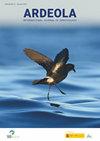Material Type and Position Determines the Insulative Properties of Simulated Nest Walls
IF 1.2
4区 生物学
Q2 ORNITHOLOGY
引用次数: 12
Abstract
Incubation in birds takes place within a nest that is often assumed to confer a degree of thermal insulation. The range, amounts and organisation of materials used to construct nest walls hampers our understanding of the degree to which they provide insulation during incubation. This experimental study used temperature loggers in a model system to test the insulative properties of materials extracted from bird nests to determine: 1) whether differences existed in terms of insulation, and 2) if the position of a material mattered when two materials were tested in combination. Animal-derived materials offered better insulation than plant-derived materials, whether tested singly or in combination. Halving the mass of each material did not affect insulation conferred by the material proximal to the temperature logger. Differing thermal conductivities of the materials in contact with the temperature logger may explain these results. If a bird strategically places an animal-derived material only into a nest cup lining then it may be sufficient to provide good insulation for the whole nest. More research is needed to generate thermal conductivity data for commonly used nest materials to test this idea more rigorously in finite element heat transfer models.—Deeming, D.C., Griffiths, J.D. & Biddle, L.E. (2020). Material type and position determines the insulative properties of simulated nest walls. Ardeola, 67: 127-136.材料类型和位置决定了模拟巢墙的保温性能
鸟类的孵化是在鸟巢中进行的,鸟巢通常被认为具有一定程度的隔热作用。用于建造巢壁的材料的范围,数量和组织阻碍了我们对它们在孵化期间提供绝缘程度的理解。本实验研究在模型系统中使用温度记录仪测试从鸟巢中提取的材料的绝缘性能,以确定:1)绝缘是否存在差异,2)两种材料组合测试时,一种材料的位置是否重要。无论是单独测试还是组合测试,动物源性材料都比植物源性材料具有更好的绝缘性。将每种材料的质量减半并不影响温度记录仪附近材料所赋予的绝缘。与温度记录仪接触的材料的不同热导率可以解释这些结果。如果一只鸟策略性地将动物来源的材料只放入巢杯衬里,那么它可能足以为整个巢提供良好的绝缘。为了在有限元传热模型中更严格地验证这一想法,需要更多的研究来生成常用鸟巢材料的导热系数数据。——迪明,d.c.,格里菲斯,J.D.和比德尔,L.E.(2020)。材料类型和位置决定了模拟鸟巢墙体的保温性能。中国生物医学工程学报,37(6):127-136。
本文章由计算机程序翻译,如有差异,请以英文原文为准。
求助全文
约1分钟内获得全文
求助全文
来源期刊
CiteScore
2.30
自引率
6.20%
发文量
16
审稿时长
>12 weeks
期刊介绍:
Ardeola: International Journal of Ornithology is the scientific journal of SEO/BirdLife, the Spanish Ornithological Society. The journal had a regional focus when it was first published, in 1954. Since then, and particular during the past two decades, the journal has expanded its thematic and geographical scope. It is now a fully international forum for research on all aspects of ornithology. We thus welcome studies within the fields of basic biology, ecology, behaviour, conservation and biogeography, especially those arising from hypothesis-based research. Although we have a long publication history of Mediterranean and Neotropical studies, we accept papers on investigations worldwide.
Each volume of Ardeola has two parts, published annually in January and July. The main body of each issue comprises full-length original articles (Papersand Review articles) and shorter notes on methodology or stimulating findings (Short Communications). The publication language is English, with summaries, figure legends and table captions also in Spanish. Ardeolaalso publishes critical Book Reviewsand PhD-Dissertation Summaries; summarising ornithological theses defended in Spain. Finally there are two Spanish-language sections, Ornithological News; summarising significant recent observations of birds in Spain, and Observations of Rare Birds in Spain, the annual reports of the Spanish Rarities Committee.

 求助内容:
求助内容: 应助结果提醒方式:
应助结果提醒方式:


